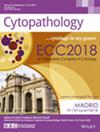Cytological Diagnosis of Amyloidosis From Orbital Papules
Abstract
Background
Amyloidosis is the extracellular accumulation of amyloid proteins in diverse organs. While ocular and periocular involvement is rare, it can be localised or part of systemic disease. This manifestation can affect various ocular structures, including the eyelids, conjunctiva, lacrimal glands, cornea, vitreous body, extraocular muscles and ocular adnexa, leading to symptoms like ptosis. Here, we report a unique case of systemic amyloidosis presenting as papulonodules on the eyelids, diagnosed through a minimally invasive fine needle aspiration technique (FNAC).
Case Presentation
A 43-year-old male presented with red to skin-coloured elevated lesions, primarily around the periocular region, persisting for 2 months. Examination revealed multiple waxy papulonodules predominantly on the eyelids, with some also in the perioral area, forehead, and neck. Additionally, the patient exhibited macroglossia with ulcers. While urine Bence Jones protein tests were negative, the urine protein creatinine ratio was elevated. Echocardiography indicated concentric left ventricular hypertrophy (LVH). FNAC from periocular papulonodules and abdominal fat pad yielded fluidy and greasy white material, respectively. The smears from eyelid lesions showed pale eosinophilic, acellular, waxy material, which was congophilic, and apple-green birefringence in polarised light. The abdominal fat pad FNAC also was positive for amyloidosis.
The subsequent skin biopsies from the patient's forehead, papules, and tongue revealed eosinophilic, amorphous extracellular material deposition. Congo red staining effectively highlighted the congophilic material. These biopsy findings aligned with the earlier FNAC results, confirming the diagnosis of amyloidosis in both.
Conclusion
This case highlights the unusual presentation of systemic amyloidosis as eyelid papules and nodules, underscoring the importance of FNAC in such scenarios. FNAC is a rapid and effective diagnostic tool for accessible lesions, as demonstrated in this case. Additionally, FNAC of abdominal fat pads can provide valuable diagnostic information swiftly, making it useful in suspected amyloidosis cases.


 求助内容:
求助内容: 应助结果提醒方式:
应助结果提醒方式:


